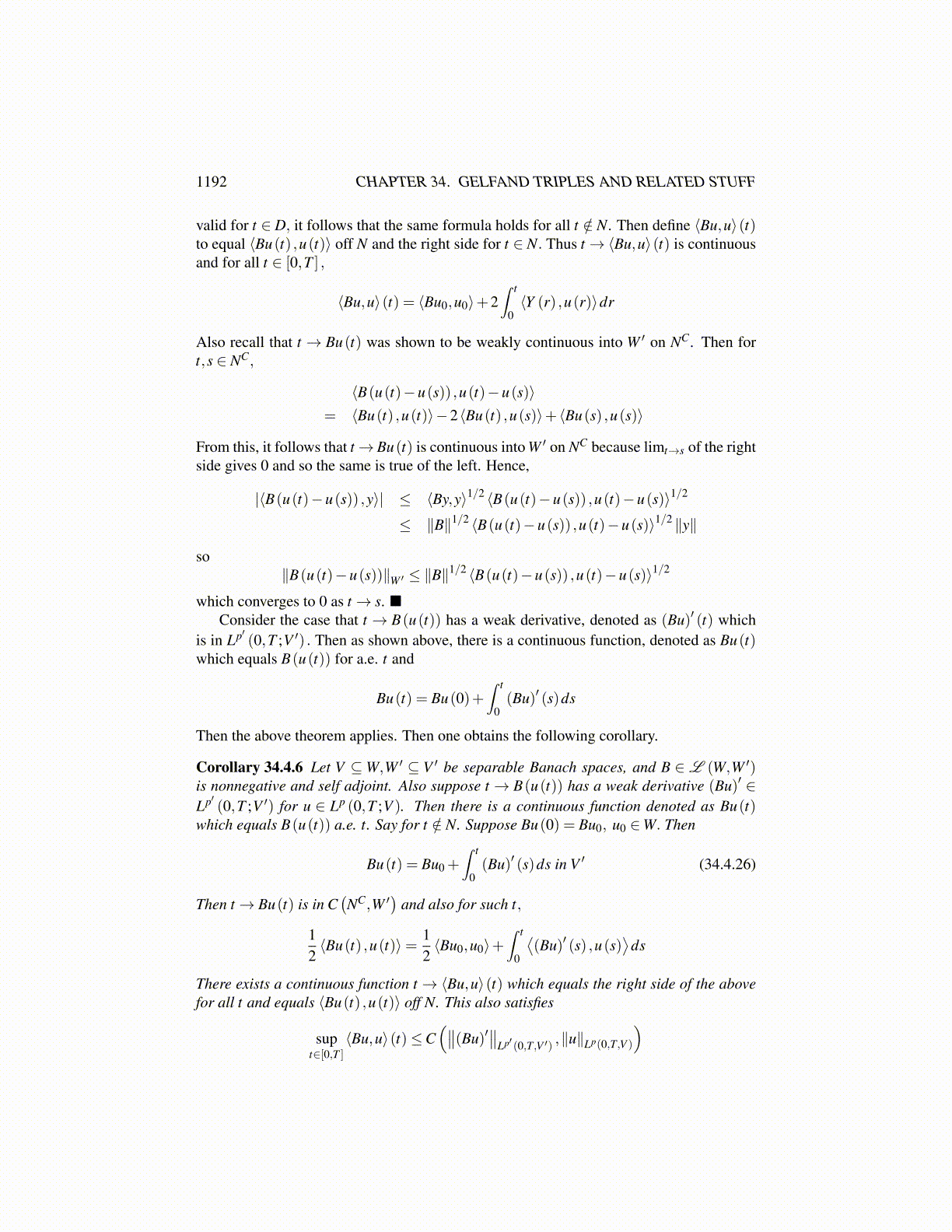
1192 CHAPTER 34. GELFAND TRIPLES AND RELATED STUFF
valid for t ∈ D, it follows that the same formula holds for all t /∈ N. Then define ⟨Bu,u⟩(t)to equal ⟨Bu(t) ,u(t)⟩ off N and the right side for t ∈ N. Thus t→ ⟨Bu,u⟩(t) is continuousand for all t ∈ [0,T ] ,
⟨Bu,u⟩(t) = ⟨Bu0,u0⟩+2∫ t
0⟨Y (r) ,u(r)⟩dr
Also recall that t → Bu(t) was shown to be weakly continuous into W ′ on NC. Then fort,s ∈ NC,
⟨B(u(t)−u(s)) ,u(t)−u(s)⟩= ⟨Bu(t) ,u(t)⟩−2⟨Bu(t) ,u(s)⟩+ ⟨Bu(s) ,u(s)⟩
From this, it follows that t→ Bu(t) is continuous into W ′ on NC because limt→s of the rightside gives 0 and so the same is true of the left. Hence,
|⟨B(u(t)−u(s)) ,y⟩| ≤ ⟨By,y⟩1/2 ⟨B(u(t)−u(s)) ,u(t)−u(s)⟩1/2
≤ ∥B∥1/2 ⟨B(u(t)−u(s)) ,u(t)−u(s)⟩1/2 ∥y∥
so∥B(u(t)−u(s))∥W ′ ≤ ∥B∥
1/2 ⟨B(u(t)−u(s)) ,u(t)−u(s)⟩1/2
which converges to 0 as t→ s.Consider the case that t → B(u(t)) has a weak derivative, denoted as (Bu)′ (t) which
is in Lp′ (0,T ;V ′) . Then as shown above, there is a continuous function, denoted as Bu(t)which equals B(u(t)) for a.e. t and
Bu(t) = Bu(0)+∫ t
0(Bu)′ (s)ds
Then the above theorem applies. Then one obtains the following corollary.
Corollary 34.4.6 Let V ⊆W,W ′ ⊆ V ′ be separable Banach spaces, and B ∈ L (W,W ′)is nonnegative and self adjoint. Also suppose t → B(u(t)) has a weak derivative (Bu)′ ∈Lp′ (0,T ;V ′) for u ∈ Lp (0,T ;V ). Then there is a continuous function denoted as Bu(t)which equals B(u(t)) a.e. t. Say for t /∈ N. Suppose Bu(0) = Bu0, u0 ∈W. Then
Bu(t) = Bu0 +∫ t
0(Bu)′ (s)ds in V ′ (34.4.26)
Then t→ Bu(t) is in C(NC,W ′
)and also for such t,
12⟨Bu(t) ,u(t)⟩= 1
2⟨Bu0,u0⟩+
∫ t
0
⟨(Bu)′ (s) ,u(s)
⟩ds
There exists a continuous function t → ⟨Bu,u⟩(t) which equals the right side of the abovefor all t and equals ⟨Bu(t) ,u(t)⟩ off N. This also satisfies
supt∈[0,T ]
⟨Bu,u⟩(t)≤C(∥∥(Bu)′
∥∥Lp′ (0,T,V ′) ,∥u∥Lp(0,T,V )
)